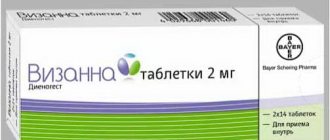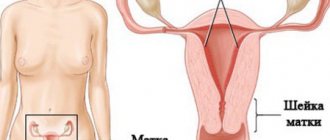Adenomyosis is one of the most common diseases in women. This disease is characterized by pathological proliferation of endometrial cells, which negatively affects the reproductive system and overall women's health.
Adenomyosis has four stages of development, each of which differs in the extent of damage to the genital organs and the depth of penetration of growing cells into the tissue. However, the diagnosis of adenomyosis is not a death sentence, since this disease is benign and very rarely develops into oncology.
Nowadays, adenomyosis can be easily treated, and in order for the pathology to stop its rapid development, it is enough to choose the right drug therapy. In addition, drug treatment allows a woman to become pregnant on her own and bear a healthy child.
The effect of Duphaston on the endometrium
Not long ago, Duphaston was actively used for the treatment and prevention of endometriosis, since it was believed that the effect of the drug leads to a decrease in the number and size of foci of the uterine and ectopic endometrium. However, recent research in this area proves the opposite, so today the drug is prescribed for endometriosis much less frequently.
Its basis is a synthetic analogue of the hormone progesterone - dydrogesterone. It affects the functioning of not only the genital organs, but also the mammary glands, as well as all structures that are normally sensitive to sex hormones.
Progesterone begins to be synthesized immediately after ovulation. It promotes a special glandular transformation of the endometrium, which is necessary for the subsequent implantation of the fertilized egg into it in the event of pregnancy.
The effect of synthetic Duphaston on the endometrium depends on the clinical situation in which it is prescribed:
- For endometriosis . It is believed that one of the reasons for the appearance of ectopic foci of the endometrium is an imbalance between estrogens and gestagens. Duphaston for endometriosis leads to a decrease in the severity of symptoms of the disease, but only for the duration of therapy. The lesions themselves do not change in any way under the influence of the drug; they remain the same size and number, and some studies even claim an increase in the number of ectopias.
- In healthy women . Duphaston enhances the glandular transformation (change) of the endometrium, which is used as “support” when performing IVF and other methods of assisted reproductive technologies.
- If there is endometrial hyperplasia. Duphaston leads to normalization of endometrial growth, reducing the likelihood of polyps appearing. This is achieved due to the fact that the balance between estrogens and gestagens is restored in such women when taking the drug. And initially the balance is disturbed.
- For infertility . The prescription of Duphaston in this case is indicated for “thin endometrium”, since the drug leads to its growth - it becomes “thick”, “loose”, ready for implantation.
- With an irregular cycle . Duphaston is prescribed according to the following regimen: 10 mg once or twice a day for 10 days, and subsequent withdrawal of the drug leads to rejection of the inner layer of the uterus and cleansing of the cavity. Menstruation begins. The property is based on the fact that Duphaston promotes the secretory transformation of the endometrium, after which it is “ready” to either accept the fertilized egg (in case of pregnancy) or be rejected to resume the cycle.
We recommend reading about how to take Duphaston if your period is late. From the article you will learn about the effect of Duphaston on the female body, indications for use, dosage regimens for delayed periods.
And here is more information about the treatment of endometrial hyperplasia without curettage.
What drugs are used to treat adenomyosis?
Adenomyosis is one of the most common diseases in women.
This disease is characterized by pathological proliferation of endometrial cells, which negatively affects the reproductive system and overall women's health. Adenomyosis has four stages of development, each of which differs in the extent of damage to the genital organs and the depth of penetration of growing cells into the tissue. However, the diagnosis of adenomyosis is not a death sentence, since this disease is benign and very rarely develops into oncology.
Nowadays, adenomyosis can be easily treated, and in order for the pathology to stop its rapid development, it is enough to choose the right drug therapy. In addition, drug treatment allows a woman to become pregnant on her own and bear a healthy child.
When is therapy needed?
Treatment of adenomyosis is prescribed for each patient individually. After making a diagnosis, the doctor selects the most suitable drug, which during therapy stops the uncontrolled proliferation of cells.
However, adenomyosis does not always require treatment.
Thus, drug therapy is necessary only if a woman has the following complaints:
- disruptions in the cycle, characterized by delayed menstruation;
- painful and too heavy periods;
- pain in the lower abdomen in the middle of the cycle and before the onset of menstruation;
- pronounced symptoms of adenomyosis, especially for women of childbearing age;
- problems with conception.
Drugs for therapy are selected in accordance with certain factors that must always be taken into account for successful treatment, namely:
- the presence of contraindications to the existing components of the drug;
- age of the patient;
- whether there is a history of psychological illnesses;
- the presence of additional diseases, such as hyperplasia, adhesions of the fallopian tubes, scarring, etc.
In addition, when prescribing medications, one should take into account whether or not the patient plans to become a mother at the time of visiting the doctor.
Types of drugs for treatment
The most effective treatments for adenomyosis are hormonal drugs. It is these medications that have numerous positive reviews from doctors, as they help eliminate pathological cell proliferation in the shortest possible time and provide improved reproductive function.
The main hormonal agents in the treatment of adenomyosis are:
- drugs containing synthetically reduced estrogen;
- hormonal based on progesterone;
- androgens;
- medications containing the hormone gonadotropin or substances similar in action.
Estrogen-based hormonal products help simulate the presence of pregnancy. They are prescribed to those patients who plan to conceive immediately after treatment for adenomyosis. In addition, estradiol actively takes part in stopping the pathological proliferation of cells in the endometrium and reduces painful symptoms in the lower abdomen.
Progesterone is a hormone secreted by the ovaries. Treatment of adenomyosis with drugs containing progestin helps restore the cycle and normalize ovulatory processes, which is necessary for a woman to become pregnant.
Treatment for adenomyosis, which includes androgen-based drugs, involves complete cessation of menstruation. This normalizes the condition of the uterus, stops monthly disruptions in the hormonal system and stops the spread of pathological foci.
Gonadotropin allows you to optimize the production of estradiol, which stops uncontrolled cell proliferation. But such drugs are used infrequently, as they affect the development of osteoporosis.
Janine
A popular and quite effective drug for adenomyosis is Janine. Many women know it, since these pills are often used as contraception.
Its advantage is that it has a minimal list of side effects, since the hormones included in its composition are contained in very small quantities. In addition, the drug Janine is easily absorbed by the body, so there is no need to increase its dosage.
The main Janine is:
The first hormone inhibits the pathological proliferation of endometrial cells, which stops the development of adenomyosis until its complete disappearance. Estrogen, in turn, activates the growth of the ovarian follicle, which promotes ovulation.
Duphaston
The hormonal drug Duphaston contains an artificial analogue of natural progesterone, which is secreted in a woman’s body by the corpus luteum of the ovary during ovulation.
It is precisely because of insufficient progesterone release that a disease such as adenomyosis often develops. Therefore, Duphaston therapy is prescribed in most cases of the disease and is quite effective.
Duphaston belongs to the new generation of hormonal drugs, therefore it has a minimum of side effects and is quite well tolerated. In addition, treatment with progesterone gives not only positive results, but also significantly lasting ones. Reappearance of adenomyosis after Duphaston therapy is quite rare.
Byzanne
The remedy Visanne for adenomyosis is prescribed quite often. The drug strengthens the lining of the uterus and has a gestagenic effect.
The hormone dienogest, found in Visanne, reduces the rate of reproduction of endometrial cells of the uterus by inhibiting the production of estrogen.
If during treatment with this drug you follow all the recommendations of the attending physician, then you can quite quickly stop the further development of the disease and prevent the appearance of new foci of pathological proliferation of endometrial cells.
To consolidate the positive result and prevent the recurrence of adenomyosis, Visanne must be taken for at least six months, but always under the supervision of a specialist.
Orgametril
The basis of Orgametril is the hormone linestrenol. It has the property of suppressing ovulation and delaying menstruation. For adenomyosis, this drug is prescribed to normalize the production of progesterone, the deficiency of which leads to impaired cellular growth in the uterine cavity.
Orgametril is taken for adenomyosis at a certain period of the month, namely from the 16th to 25th day of the cycle, and is prescribed only if the appearance of the disease is influenced by a lack of the hormone progesterone.
Orgametril should be taken for at least 6 months. It is with long-term treatment with linestrenol that it is possible to achieve complete disappearance of pathological foci of endometriotic cells and improve reproductive function.
However, treatment with this drug should be strictly under the supervision of a doctor. The fact is that Orgametril has a fairly large list of side effects and contraindications.
Claira
The hormonal drug Qlaira is quite often used in gynecology for the treatment of adenomyosis. It effectively eliminates further uncontrolled proliferation of endometrial cells and suppresses activity in existing lesions.
Qlaira contains two hormones: dienogest, which is an analogue of organic progesterone, and a large amount of estrogen.
Because of the latter, treatment of adenomyosis with this drug should be carried out with caution and only under the supervision of a gynecologist. The fact is that estrogen itself often provokes pathological proliferation of endometrial cells, so before using it you need to make sure that it is not the original cause of the disease.
Qlaira is prescribed at the initial stages of the development of adenomyosis, and the minimum period of its use is 6 months.
Mirena
Mirena is an intrauterine hormonal device that is inserted into the uterine cavity to prevent unwanted pregnancy.
The Mirena spiral contains a large amount of the hormone levonorgestrel, which is released daily from the device into the uterine cavity in small doses. Its advantage is that it acts exclusively in the uterus, which reduces the likelihood of ovarian suppression and reduces the risk of side effects.
Mirena is installed not only for the purpose of contraception, but also for the therapeutic treatment of certain ailments. Thus, the hormonal IUD is often used to treat uterine fibroids and adenomyosis.
Indications for installation of the Mirena coil are:
- painful menstruation;
- heavy periods;
- intermenstrual periodic spotting.
Mirena is prescribed exclusively by a gynecologist, the same applies to its installation. Under no circumstances should you try to place the IUD into the uterine cavity yourself.
Silhouette
The drug Silhouette is an analogue of such a hormonal drug as Janine. It contains two hormones, one of which stops the development of pathological foci, and the second promotes the maturation of the follicle, which guarantees timely ovulation.
Silhouette for adenomyosis is often used as an analogue of more expensive drugs. But, despite its lower cost, it is quite effective and has a minimum of side effects, since it belongs to the new generation of medicines.
The minimum course of therapy with Silhouette for adenomyosis is six months. The maximum is selected purely individually depending on the degree of development of the disease, the patient’s age and concomitant diseases.
Regulon
Regulon is better known among women as a means of contraception.
It contains:
- 30 mcg ethinyl estradiol;
- 150 mcg disegestrel.
For adenomyosis, Regulon is prescribed if the disease was caused by insufficient production of progesterone. It normalizes the functioning of the corpus luteum and ensures long-term remission after the disease subsides.
Zoladex
The main function of the drug Zoladex in the treatment of adenomyosis is to give the reproductive system a break from constant problems with hormones that provoke problems with the cycle and menstruation.
Zoladex stops the production of natural estrogen, which stops further proliferation of endometrial cells and prevents further development of lesions.
However, treatment with this drug should be carried out with caution, since its long-term use can provoke a number of undesirable effects.
Indole Forte
Indole Forte belongs to herbal preparations, the use of which helps to improve the production of the hormone progesterone and normalize the functioning of the entire reproductive system.
This remedy is prescribed not only for adenomyosis, but for any hyperplastic processes in the tissues and organs of the woman’s reproductive system.
Indole Forte stops the production of hormones that provoke pathological cell proliferation in the uterus and mammary glands.
Jess
The hormonal drug Jez in the treatment of adenomyosis is prescribed to stop the pathological proliferation of cells and normalize the menstrual cycle due to artificially synthesized hormones.
The drug belongs to a new generation of hormonal tablets, so it is quite easily tolerated by patients, and side effects with long-term use are rarely observed. However, this does not mean that you can drink it without a doctor’s prescription. Jess, like all hormonal drugs, has a number of contraindications that should be taken seriously.
Utrozhestan
Treatment of adenomyosis with Utrozhestan is recommended for insufficient production of the hormone progesterone. In addition, this drug is often prescribed for conception, as it stimulates the synthesis of normal endometrial secretions and improves the functioning of the corpus luteum of the ovary.
In addition, Utrozhestan is used to prevent miscarriage at all stages of gestation, which is quite often observed in women with a history of adenomyosis and endometriosis.
Diklovit
Diclovit suppositories for adenomyosis are prescribed to eliminate pain. In addition, they perfectly help with too heavy periods, which, due to pathological proliferation of endometrial cells, always bother women.
In addition, Diclovit is recommended for use in advanced forms of adenomyosis, which is aggravated by the inflammatory process in endometrial tissue.
The drug not only quickly relieves pain in the lower abdomen, but also helps eliminate inflammation and swelling itself.
Vitamin E
At the initial stages of the development of endometriosis, doctors often recommend that patients take vitamin E or include in their diet foods that contain this component, which is beneficial for women’s health.
Vitamin E promotes the normal production of natural progesterone and also normalizes the growth of endometrial cells.
In some cases, vitamin E is prescribed for more advanced adenomyosis. Its use in parallel with drug treatment helps to quickly regulate the pathological proliferation of cells and stop the further development of the disease.
Homeopathy
Treatment of adenomyosis with homeopathy is carried out with non-hormonal drugs, which are selected individually for each patient after a thorough diagnosis.
Gynecologists and homeopathic doctors have been arguing about the effectiveness of such treatment for several years, however, it, like hormones, is used quite often. Preparations of Western Thuja (Thuja) and Black Cohosh (Actaea racemosa) are usually used.
Most often, women who have contraindications to taking hormones or those who are afraid to take hormonal contraceptives for a long time turn to homeopathy. After all, as you know, they have a fairly extensive list of side effects, including diabetes, thrombophlebitis and other dangerous diseases.
Source: https://healthy-lady.ru/preparaty-dlya-lecheniya-adenomioza
Can endometriosis be cured with Duphaston?
It is impossible to cure endometriosis with Duphaston. Moreover, today this drug is considered absolutely useless for those who want to stop the progression of the disease.
However, prescribing medication can lead to a decrease in the severity of endometriosis symptoms (pain goes away, menstruation becomes less heavy, the cycle becomes regular). This imaginary improvement does not last long - as soon as the drug is discontinued, all unpleasant symptoms return.
Duphaston has also been proven ineffective for preventing the appearance of new foci of endometriosis in the postoperative period after removal of endomethyroid cysts or other ectopia.
Duphaston for endometriosis: how to take
However, Duphaston is prescribed for the treatment of endometriosis according to different regimens, doses, and the duration of therapy depends on the clinical situation.
The medicine is available in the form of tablets of 10 and 20 mg. Must be taken orally. Since endometriosis is often accompanied by other disorders, the particulars of admission will depend specifically on the woman’s complaints:
- For irregular cycles and endometriosis. 10-20 mg from days 11 to 25 of the menstrual cycle. Duration – from 3 months.
- For pain caused by endometriotic lesions, asymptomatic disease, as well as in the postoperative period. To reduce the signs of endometriosis, you need to drink Duphaston from days 5 to 25 of the menstrual cycle, 10-20 mg. Course - 6-12 months.
- For infertility due to endometriosis. To increase the growth of the endometrium and establish ovulation processes, Duphaston is prescribed from days 14 to 25 of the cycle for at least 6 months.
Watch this video about how to take Duphaston for endometriosis:
Types of drugs for treatment
The most effective treatments for adenomyosis are hormonal drugs. It is these medications that have numerous positive reviews from doctors, as they help eliminate pathological cell proliferation in the shortest possible time and provide improved reproductive function.
The main hormonal agents in the treatment of adenomyosis are:
- drugs containing synthetically reduced estrogen;
- hormonal based on progesterone;
- androgens;
- medications containing the hormone gonadotropin or substances similar in action.
Estrogen-based hormonal products help simulate the presence of pregnancy. They are prescribed to those patients who plan to conceive immediately after treatment for adenomyosis. In addition, estradiol actively takes part in stopping the pathological proliferation of cells in the endometrium and reduces painful symptoms in the lower abdomen.
Progesterone is a hormone secreted by the ovaries. Treatment of adenomyosis with drugs containing progestin helps restore the cycle and normalize ovulatory processes, which is necessary for a woman to become pregnant.
Treatment for adenomyosis, which includes androgen-based drugs, involves complete cessation of menstruation. This normalizes the condition of the uterus, stops monthly disruptions in the hormonal system and stops the spread of pathological foci.
Gonadotropin allows you to optimize the production of estradiol, which stops uncontrolled cell proliferation. But such drugs are used infrequently, as they affect the development of osteoporosis.
Janine
A popular and quite effective drug for adenomyosis is Janine. Many women know it, since these pills are often used as contraception.
Its advantage is that it has a minimal list of side effects, since the hormones included in its composition are contained in very small quantities. In addition, the drug Janine is easily absorbed by the body, so there is no need to increase its dosage.
The main Janine is:
- gestagen;
- estrogen.
The first hormone inhibits the pathological proliferation of endometrial cells, which stops the development of adenomyosis until its complete disappearance. Estrogen, in turn, activates the growth of the ovarian follicle, which promotes ovulation.
Duphaston
The hormonal drug Duphaston contains an artificial analogue of natural progesterone, which is secreted in a woman’s body by the corpus luteum of the ovary during ovulation.
It is precisely because of insufficient progesterone release that a disease such as adenomyosis often develops. Therefore, Duphaston therapy is prescribed in most cases of the disease and is quite effective.
Duphaston belongs to the new generation of hormonal drugs, therefore it has a minimum of side effects and is quite well tolerated. In addition, treatment with progesterone gives not only positive results, but also significantly lasting ones. Reappearance of adenomyosis after Duphaston therapy is quite rare.
Byzanne
The remedy Visanne for adenomyosis is prescribed quite often. The drug strengthens the lining of the uterus and has a gestagenic effect.
The hormone dienogest, found in Visanne, reduces the rate of reproduction of endometrial cells of the uterus by inhibiting the production of estrogen.
If during treatment with this drug you follow all the recommendations of the attending physician, then you can quite quickly stop the further development of the disease and prevent the appearance of new foci of pathological proliferation of endometrial cells.
To consolidate the positive result and prevent the recurrence of adenomyosis, Visanne must be taken for at least six months, but always under the supervision of a specialist.
Orgametril
The basis of Orgametril is the hormone linestrenol. It has the property of suppressing ovulation and delaying menstruation. For adenomyosis, this drug is prescribed to normalize the production of progesterone, the deficiency of which leads to impaired cellular growth in the uterine cavity.
Orgametril is taken for adenomyosis at a certain period of the month, namely from the 16th to 25th day of the cycle, and is prescribed only if the appearance of the disease is influenced by a lack of the hormone progesterone.
Orgametril should be taken for at least 6 months. It is with long-term treatment with linestrenol that it is possible to achieve complete disappearance of pathological foci of endometriotic cells and improve reproductive function.
However, treatment with this drug should be strictly under the supervision of a doctor. The fact is that Orgametril has a fairly large list of side effects and contraindications.
Claira
The hormonal drug Qlaira is quite often used in gynecology for the treatment of adenomyosis. It effectively eliminates further uncontrolled proliferation of endometrial cells and suppresses activity in existing lesions.
Qlaira contains two hormones: dienogest, which is an analogue of organic progesterone, and a large amount of estrogen.
Because of the latter, treatment of adenomyosis with this drug should be carried out with caution and only under the supervision of a gynecologist. The fact is that estrogen itself often provokes pathological proliferation of endometrial cells, so before using it you need to make sure that it is not the original cause of the disease.
Qlaira is prescribed at the initial stages of the development of adenomyosis, and the minimum period of its use is 6 months.
Contraindications and side effects
Considering the hormonal nature of the drug, Duphaston has a number of restrictions on its use:
- individual hypersensitivity to the drug;
- serious liver dysfunction;
- predisposition to thrombosis and thromboembolism.
Risk of thrombosis and thromboembolism
The drug should not be combined with alcoholic beverages, as this may lead to a decrease in the effectiveness of treatment and disruption of the liver.
Side effects include:
- headaches, migraines, dizziness;
- heavy periods;
- engorgement and tenderness of the mammary glands;
- allergic manifestations;
- increased levels of liver enzymes with long-term use.
Duphaston, Utrozhestan or Visanne for endometriosis - which is better
Duphaston, Utrozhestan and Visanne belong to the same group of drugs - gestagens, and theoretically can be used in the treatment of endometriosis, but the latter remedy works best.
Numerous studies in recent years have shown the clear benefits and effectiveness of Visanne in the fight against endometriosis. The drug contains dienogest. It has been proven that regular use leads to a significant reduction in the size of endometrioid ectopia, some of them disappear altogether. In addition, abnormal vascular growth in areas of endometriosis is reduced and immune defense is enhanced.
The main advantage of Visanne is that after treatment, the symptoms of the disease do not return, as happens after taking oral contraceptives or gestagens, including Duphaston. The drug does not affect liver function or hematopoiesis in the body, but still has a number of contraindications and unwanted reactions from the body.
To achieve a noticeable effect, you must take the drug for at least three to six months.
The effectiveness of Visanne in the treatment of endometriosis
Our readers successfully use Monastic tea to treat the thyroid gland. Seeing how popular this product is, we decided to bring it to your attention. Read more here...
The drug Visanne is an effective drug for the treatment of endometriosis in women of reproductive age.
The disease is characterized by the formation of the functional layer of the uterus in areas unusual for this.
The main purpose of using the drug is to eliminate the symptoms of endometriosis while suppressing the activity of pathological areas.
Dosage form and components included in the drug
Medicine Visanne - tablets. The medicine is produced by the German pharmacological company.
One package contains 28 pills for monthly use or 84 capsules for use for 3 months.
In order not to lead to this and not feel constant dependence on pills, we recommend Monastic Tea - the only natural remedy that is designed to restore thyroid function, generally normalize hormonal levels and prevent diseases associated with its disruption. It consists ONLY of natural ingredients and has no unpleasant side effects. This drug is not sold in pharmacies and is not advertised on the Internet. So that you don’t think that they are selling you another “panacea for all diseases,” I will not describe what an effective remedy it is... If you are interested, read all the information about it yourself. Here is the link to the official website.
The tablets have a round, flattened shape, with the letter “B” engraved on one side. The pills are not intended to be divided or crushed before use.
Visanne is a hormonal drug. Its active ingredient is micronized dienogest, each tablet contains 2 mg.
Auxiliary components do not have a therapeutic effect on the body.
Duphaston, endometriosis and pregnancy
Duphaston is often prescribed during pregnancy planning and already during pregnancy in women with previously established endometriosis. Schemes and doses can vary - from 20 mg per day to 80 mg. The action of Duphaston in this case is aimed at improving the properties of the endometrium: it becomes “thicker”, the vascular network is more branched, which contributes to the fixation of the fertilized egg in the uterine cavity and the normal development of the chorion and placenta in the future.
When planning a pregnancy, Duphaston is prescribed only in the second phase, from the 14th day. It is optimal to start taking it right from the moment of ovulation, this will contribute to the maximum therapeutic effect. To determine the moment of full maturation of the follicle, you can use ovulation tests or, more precisely, ultrasound.
To get pregnant, you need to take Duphaston for 10 days, after which menstruation begins. If you do not have your period, you need to take a pregnancy test and, if the result is positive, continue taking the pills.
During pregnancy, Duphaston should be taken continuously. The standard maintenance dose is 20 mg, one tablet twice a day. In case of complicated pregnancy, threat, uterine tone or mucous secretions, the doctor may increase the dose several times for a certain period of time. You are allowed to drink Duphaston up to 37 weeks, but this need can only be determined by a specialist.
Watch this video about the indications and mechanism of action of Duphaston during pregnancy:
Janine and endometriosis, when prescribed
Janine and endometriosis are compatible concepts. Very often, this drug is prescribed for the growth of the uterine mucosa. The medicine is prescribed for polycystic ovary syndrome, endometritis and “chocolate” cysts.
The mechanism of action of janine is based on preventing the decrease in female sex hormones. Its basis is dienogest, an analogue of the female sex hormone. This active ingredient has a depressant effect.
Another important component of the drug is estradiol. It is a type of estrogen produced by the ovaries. Estradiol promotes active growth of ovarian follicles. To normalize the menstrual cycle and eliminate pathological changes in the uterus, Zhanine and Duphaston are the drugs of choice. Both have minimal side effects. With the correct dosage, there are no complications from taking these tablets.
Janine and endometriosis is a topic actively discussed in medical circles. The drug recently appeared on the domestic market, but in a short time it showed a good therapeutic effect for this disease.
However, there are other popular medications for this disease.
Duphaston: reviews from women with endometriosis
Positive reviews from women about Duphaston in the treatment of endometriosis are due to some improvement in symptoms while taking the drug. However, many note that ultrasound signs of endometriosis remained at the same level. Positive reviews can only be seen from those whose disease was not pronounced. At stages 3-4 of endometriosis, Duphaston will not help at all.
Also, many note that it was on synthetic progesterone that pregnancy began to develop; in the early stages there was no detachment or threat of miscarriage.
The use of Duphaston at stages 3-4 of endometriosis will not give results
Duphaston
of dydrogesterone as the active component of the tablets
.
This is a synthetic hormone, similar in structure and pharmacology to natural progesterone. A significant difference between Duphaston and Visanne is that it does not suppress ovulation and patients who take it retain normal, regular menstruation and the possibility of pregnancy .
Therefore, when treating infertility due to decreased ovarian function due to endometriosis, the doctor may prescribe Duphaston after a course of Visanne. Medical publications and clinical studies report the effectiveness of dydrogesterone in reducing the symptoms of endometriosis, although its mechanism of action is still a matter of debate. Nevertheless, Duphaston helps well in relieving pain in the lower abdomen, caused not only by problems with the endometrium, but also by PMS.
Dydrogesterone may also be appropriate for post-laparoscopic treatment of endometriosis. Studies have confirmed that after surgery, taking Duphaston from the 5th to the 25th day of the cycle (1-2 times a day) for 3-6 cycles reduced pelvic pain and dysmenorrhea in 90% of subjects.
Duphaston has been available on the pharmacy market for many years, so the cost of treatment with it compared to Visanne is much lower.
What's better?
Doctors prescribe Duphaston or Visanne based on the goals of treatment - the presence of infertility or the desire to become pregnant with endometriosis, the severity of pain, an assessment of the general condition and risk factors.
Visanne is effective in the conservative treatment of endometriosis, providing a long period of remission after completion of the course. Can be used in complex preparation for IVF.
Duphaston may become the drug of choice after endometrial surgery or for the treatment of infertility with reduced corpus luteum function due to progesterone deficiency. Suitable for maintaining pregnancy in the early stages or when there is a threat of miscarriage.
Despite the good safety profile of both drugs, therapy with progestins requires systematic monitoring. During treatment, it is important for a woman to be observed by a mammologist and gynecologist. Once every 3 months, conduct a physical and ultrasound examination of the mammary glands, pelvic organs, and cervical cytology.
Adenomyosis is one of the most common diseases in women. This disease is characterized by pathological proliferation of endometrial cells, which negatively affects the reproductive system and overall women's health.
Adenomyosis has four stages of development, each of which differs in the extent of damage to the genital organs and the depth of penetration of growing cells into the tissue. However, the diagnosis of adenomyosis is not a death sentence, since this disease is benign and very rarely develops into oncology.
Nowadays, adenomyosis can be easily treated, and in order for the pathology to stop its rapid development, it is enough to choose the right drug therapy. In addition, drug treatment allows a woman to become pregnant on her own and bear a healthy child.
Doctors' reviews about the drug
Positive reviews of Duphaston treatment can only be heard from those doctors who do not maintain feedback with their patients and do not monitor the dynamics of their disease. Modern specialists, who are constantly improving their level of education, have not used Duphaston for a long time for the treatment and prevention of endometriosis, but only as part of complex therapy for other pathologies.
For example, it is used to reduce the likelihood of miscarriage in women with endometriosis, to improve the quality of the endometrium with adenomyosis during planning.











